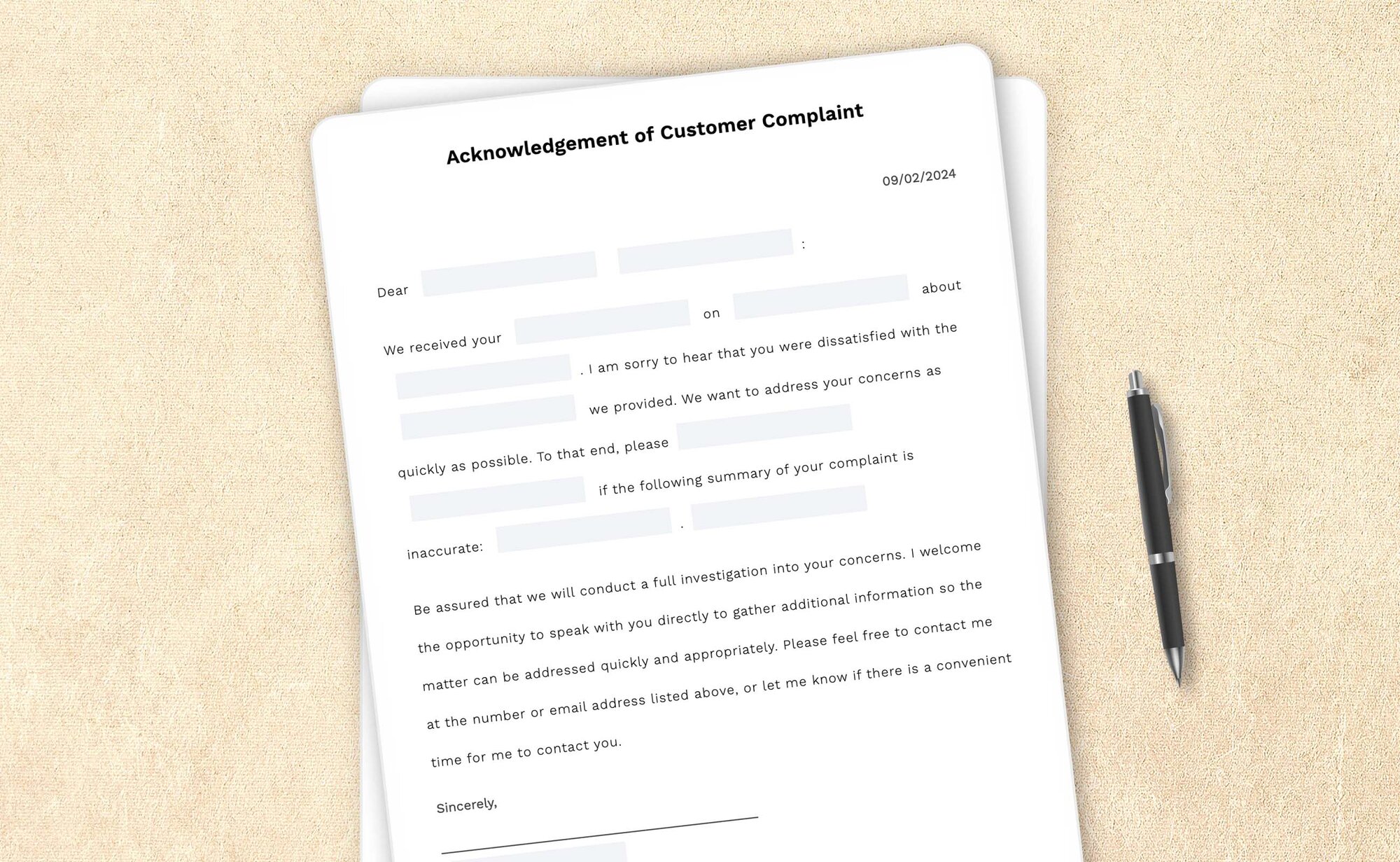Dear
We received your
Be assured that we will conduct a full investigation into your concerns. I welcome the opportunity to speak with you directly to gather additional information so the matter can be addressed quickly and appropriately. Please feel free to contact me at the number or email address listed above, or let me know if there is a convenient time for me to contact you.
| Sincerely, | |||||||||||||||||||||
_____________________________________________ |
How-to guides, articles, and any other content appearing on this page are for informational purposes only, do not constitute legal advice, and are no substitute for the advice of an attorney.
Acknowledgment of customer complaint: How-to guide
The backbone of any successful company is happy and satisfied customers. In any business, handling customer complaints to their satisfaction is crucial to building a loyal customer base. A customer complaint can include any statement of dissatisfaction by a customer about services or products they received.
Provide customers the care they deserve and value them with a well-trained customer service team. A customer complaint acknowledgment letter is a good starting point to address your customer’s concerns.
A well-constructed acknowledgment letter allows you to maintain relationships and build your business. The letter template on this page provides a good framework for a complaint response. Answer simple questions to complete the letter tailored to the specific event. Follow up with a phone call to ensure that your message was received and to provide any additional information that may be helpful.
Ensure that every customer service representative is qualified enough to handle customer expectations and can alleviate their frustration with the best course of action.
Best practices to address customer complaints

1. Creating policies for handling complaints
Instituting company policies for handling complaints is as crucial as taking the complaint. These should provide a dissatisfied or angry customer with a way to resolve their issues and allow your company to improve its performance. Clear and consistent company policies will let you track problems and address concerns quickly and efficiently.
2. Making the process easy and accessible
It is crucial to ensure that your customers know how to file complaints. Make the process easy and accessible for your customers.
3. Considering customer needs through proper communication
It is crucial to address your customer needs and frustrations promptly. Passing the call of aggrieved customers from one representative to another, having the complaint handled by multiple individuals, and forcing them to contact you at your convenience may make the resolution experience worse than the initial problem.
- Communicating with customers respectfully and through the channel of their convenience is essential for building strong business relationships.
- Emphasize that your organization takes complaints seriously and will quickly investigate and resolve the issue using the most appropriate channels, such as chat, phone, email, and more.
- If the customer disagrees with the solution, provide further assistance by contacting your support team to correct any misunderstandings with additional details.
4. Acknowledging the complaint
Acknowledge the customer's complaint and frustration. Many people who experience poor service or receive defective products don't bother to file a complaint. Therefore, if a customer takes the time to contact you, it is highly likely that the customer's feelings require validation.
5. Addressing the complaints at the earliest
It is crucial to take customer complaints seriously and address them effectively. Ignoring customer's concerns and complaints risks harming your business's reputation and losing potential customers. Taking immediate action to address the issue and finding a solution can help prevent future mistakes and maintain customer loyalty.
6. Maintaining records of the complaints received
It is vital to keep a record of every complaint that you receive. It is best to categorize each complaint to ensure it is addressed and organized appropriately. You should ensure that this information is provided to sales team managers, executives, and any other teams so that they can perform adequate market research and evaluate the effectiveness of their operations.
7. Follow-up to build goodwill
Follow up with your customer to ensure that the issues underlying the complaint are resolved and that the customer is satisfied with the outcome.
Use LegalZoom’s acknowledgment of customer complaint letter template to create your documents
Using LegalZoom’s acknowledgment of customer complaint letter template for an affordable price simplifies the process of responding to customer complaints with professionalism and efficiency. Our letter template guides you in crafting a response that acknowledges the issue, reassures the customer, and outlines the steps being taken to resolve the problem.
By using this template, you can maintain a consistent tone, reduce drafting time, and avoid missing critical details, ultimately enhancing your customer service and building stronger relationships with your clients. Our template can be easily customized to suit the specifics of each complaint.
LegalZoom also offers a wide collection of letter samples that you can use for various professional and personal settings.
Frequently asked questions
What's an acknowledgment of a customer complaint?
When there are customer complaints, the company can respond by handling the concern to show that they care about the customer's concerns. Acknowledging a customer complaint can address a complaint in a way that can win the customer back. It aids in customer retention, earning recommendations, and improving your business operations for the future.
